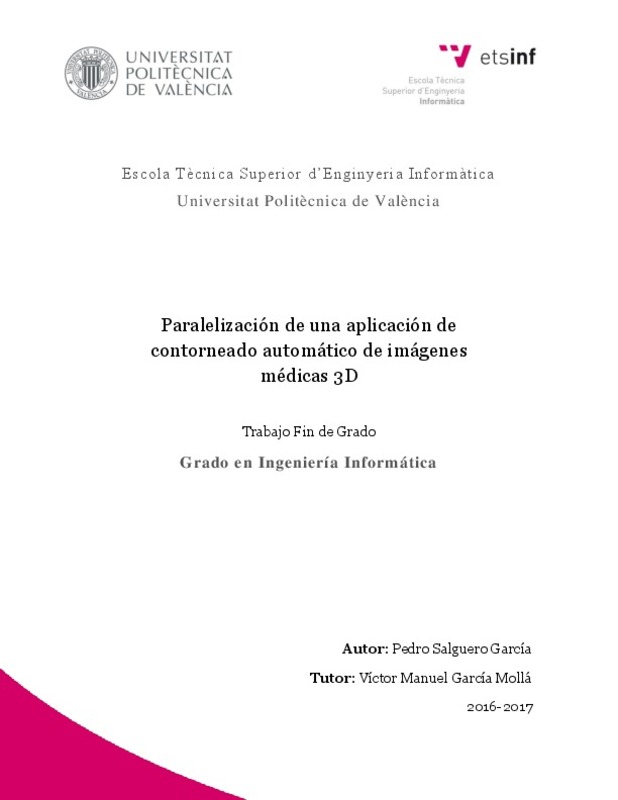JavaScript is disabled for your browser. Some features of this site may not work without it.
Buscar en RiuNet
Listar
Mi cuenta
Estadísticas
Ayuda RiuNet
Admin. UPV
Paralelización de una aplicación de contorneado automático de imágenes médicas 3D
Mostrar el registro sencillo del ítem
Ficheros en el ítem
| dc.contributor.advisor | García Mollá, Víctor Manuel
|
es_ES |
| dc.contributor.author | Salguero García, Pedro
|
es_ES |
| dc.date.accessioned | 2017-09-07T08:29:52Z | |
| dc.date.available | 2017-09-07T08:29:52Z | |
| dc.date.created | 2017-07-17 | |
| dc.date.issued | 2017-09-07 | es_ES |
| dc.identifier.uri | http://hdl.handle.net/10251/86669 | |
| dc.description.abstract | [ES] Trabajar con grandes cantidades de datos de una manera inadecuada, el acceso a ellos y la manera de realizar los cálculos a la hora de programar puede afectar enormemente y de manera negativa al tiempo de ejecución de cualquier aplicación. Cuando se trata con imágenes médicas para la segmentación automática debemos hacer frente a todos estos problemas, y para solucionarlos vamos a hacer uso tanto de la paralelización de la aplicación entre distintos núcleos de procesamiento, como de la reorganización de código y uso correcto de los datos para conseguir una mejora en el tiempo de cómputo del programa. Por otro lado, se ha intentado abordar el problema del contorneado automático de órganos usando redes neuronales artificiales, prescindiendo de la anterior aplicación para buscar un mayor índice de acierto y proporcionar mejores resultados usando esta tecnología. | es_ES |
| dc.description.abstract | [EN] Working with large amounts of data in an inadequate form, the access to it and the way to perform calculations when programming can affect enormously and negatively to the time of execution of any application. When it comes to automatic segmentation of medical images we must face all the problems mentioned and solve them, to do that we need to use both the parallelization of the application between different processing cores, and the reorganization of code and the correct usage of data to get an improvement in the computing time of the program. On the other hand, we have tried to solve the problem about automatic segmentation of organs using artificial neural networks without the previous application to get a higher success rate and better results using this technology. | es_ES |
| dc.format.extent | 84 | es_ES |
| dc.language | Español | es_ES |
| dc.publisher | Universitat Politècnica de València | es_ES |
| dc.rights | Reserva de todos los derechos | es_ES |
| dc.subject | Paralelización | es_ES |
| dc.subject | Imagen médica | es_ES |
| dc.subject | Segmentación | es_ES |
| dc.subject | Redes neuronales | es_ES |
| dc.subject | Paralellization | es_ES |
| dc.subject | Medical image | es_ES |
| dc.subject | Segmentation | es_ES |
| dc.subject | Neuronal networks | es_ES |
| dc.subject.classification | CIENCIAS DE LA COMPUTACION E INTELIGENCIA ARTIFICIAL | es_ES |
| dc.subject.other | Grado en Ingeniería Informática-Grau en Enginyeria Informàtica | es_ES |
| dc.title | Paralelización de una aplicación de contorneado automático de imágenes médicas 3D | es_ES |
| dc.type | Proyecto/Trabajo fin de carrera/grado | es_ES |
| dc.rights.accessRights | Abierto | es_ES |
| dc.contributor.affiliation | Universitat Politècnica de València. Escola Tècnica Superior d'Enginyeria Informàtica | es_ES |
| dc.contributor.affiliation | Universitat Politècnica de València. Departamento de Sistemas Informáticos y Computación - Departament de Sistemes Informàtics i Computació | es_ES |
| dc.description.bibliographicCitation | Salguero García, P. (2017). Paralelización de una aplicación de contorneado automático de imágenes médicas 3D. http://hdl.handle.net/10251/86669. | es_ES |
| dc.description.accrualMethod | TFGM | es_ES |
| dc.relation.pasarela | TFGM\56169 | es_ES |
Este ítem aparece en la(s) siguiente(s) colección(ones)
-
ETSINF - Trabajos académicos [5160]
Escola Tècnica Superior d'Enginyeria Informàtica






